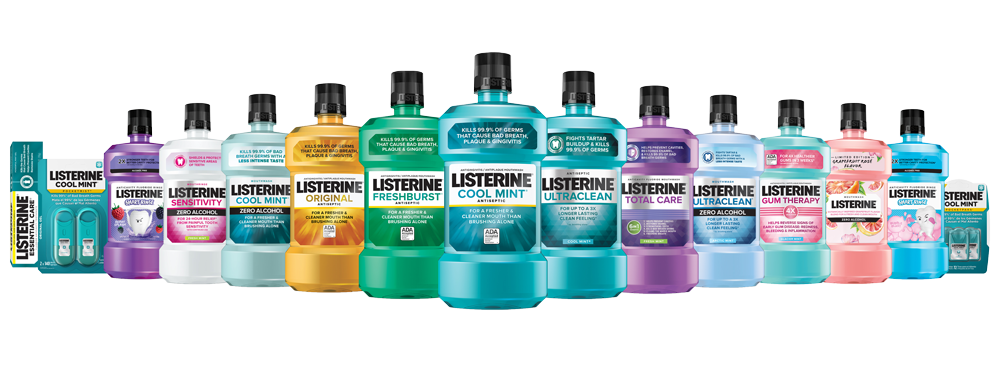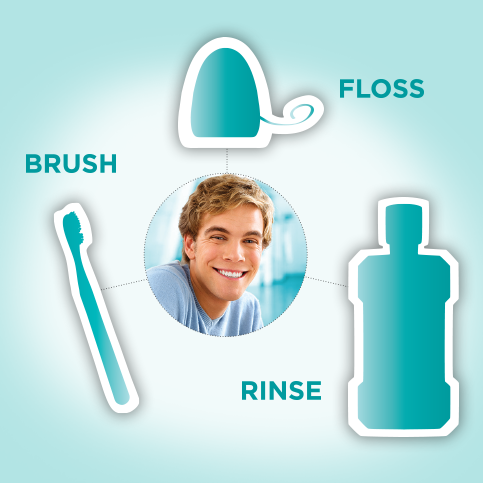

Licensed professionals can receive the latest Listerine clinical information and patient resources.
WHAT YOUR PATIENTS SHOULD KNOW ABOUT MOUTHRINSES AND THE IMPORTANCE OF THE ADA SEAL
There are many reasons for patients to use a mouthrinse—to freshen breath, to help prevent or control tooth decay, to reduce plaque, to prevent or reduce gingivitis, to reduce the speed at which tartar forms on the teeth, or to achieve a combination of these outcomes. Although some mouthrinses are by prescription only, most are available over the counter.1
The most commonly found ingredients in mouthrinse include water, alcohol, cleansing agents, flavoring ingredients, and coloring agents. Depending on the type of mouthrinse, the active ingredients may vary. However, they can be classified into 4 basic groups1:
- Antimicrobial agents: by acting directly on oral bacteria, these agents help reduce plaque, decrease the degree of gingivitis, and control bad breath
- Fluoride: this ingredient helps reduce tiny lesions on tooth enamel, making teeth less susceptible to decay
- Astringent salts: these temporary deodorizers can be used to cover up bad breath
- Odor neutralizers: these agents work by chemically inactivating the compounds that cause breath odor
Although cosmetic mouthrinses leave the mouth with a pleasant taste, the effects are only temporary. The reason is because these mouthrinses do not kill the bacteria that cause bad breath. Furthermore, none of the cosmetic mouthrinses are formulated to help reduce plaque, gingivitis, or cavities.1
If the goal is to reduce plaque, gingivitis, cavities, and bad breath, a therapeutic mouthrinse should be used. Some of these mouthrinses fight the bacteria present in plaque, as these bacteria can damage the gums. There are therapeutic mouthrinses that also contain agents that fight bad breath bacteria, or that chemically inactivate odor causing compounds. The ones that contain fluoride can help prevent or reduce tooth decay.1
Whether it’s called anti-plaque, anti-gingivitis, antibacterial, antimicrobial, or chemotherapeutic, these mouthrinses all reduce bacterial count and help prevent the bacterial activity that can lead to gingivitis.1
Look for the ADA seal when choosing a mouthrinse, as a product can only earn the ADA seal after submitting scientific evidence that it is safe and effective. The ADA Council on Scientific Affairs, an independent body of scientific experts, will then evaluate the evidence to ensure it meets the ADA criteria for safety and efficacy. The prestigious ADA Seal assures that all claims made by a mouthrinse have been reviewed and approved by the ADA. Moreover, this means the products “must say what they do and do what they say”1.
ADA Seal of Acceptance
LISTERINE® Antiseptic rinses carry the ADA Seal of Acceptance on the bottle*.
ADA Recognizes the Benefits of Rinsing
Brushing and flossing are both important parts of good oral health, and the ADA recognizes the benefits of rinsing.
Selecting a Mouthrinse Footnotes
*LISTERINE® Brand rinses carrying the ADA Seal of Acceptance include LISTERINE® Antiseptic, LISTERINE® COOL MINT® Antiseptic, LISTERINE® FRESHBURST® Antiseptic, LISTERINE® SOFT MINT® Antiseptic, and LISTERINE® SMART RINSE® (Mint Shield®, FAB BUBBLE GUM®, Bubble Blast®).
References: 1. American Dental Association. Learn more about mouthrinses. http://www.ada.org/en/science-research/ada-seal-of-acceptance/product-ca.... Accessed October 30, 2015.





All Fields required, unless otherwise indicated
Personal Information
Step 1
Will be used as your user name
By submitting your information above, you agree that the information you provide will be governed by our site's Privacy Policy.